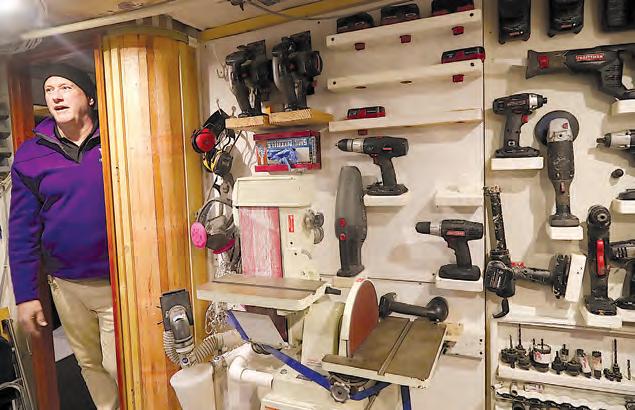Services Center helps make Fisher Houses homes away from home




SCOTT AIR FORCE BASE, IL — An intense operations tempo and constant calls for mobility capabilities in support of the Nation’s most important missions is nothing new for Air Mobility Command airmen, but in many ways 2022 stood apart as the command intensified its focus on solving future challenges while remaining wholly responsive to today’s requirements. Mobility airmen stepped up to the challenge, employing their ingenuity, grit and passion in ways no one could have predicted. Early in the year, AMC airmen once again took the international stage as they postured for adaptive support to Ukraine, delivering hope in the form of millions of pounds of equipment and other critical security assistance. These missions, augmented by commercial partners, continued throughout the year.
“This is a testament to U.S. Transportation Command’s ability to rapidly project and sustain, whenever and wherever our nation requires,” said Gen. Jacqueline Van Ovost, USTRANSCOM commander. “Our commitment to delivering security assistance to our Ukrainian partners remains steadfast.”
Mobility airmen were also critical to responding to the national baby formula crisis, underscoring AMC’s capabilities to give leaders options to meet strategic mobility challenges.
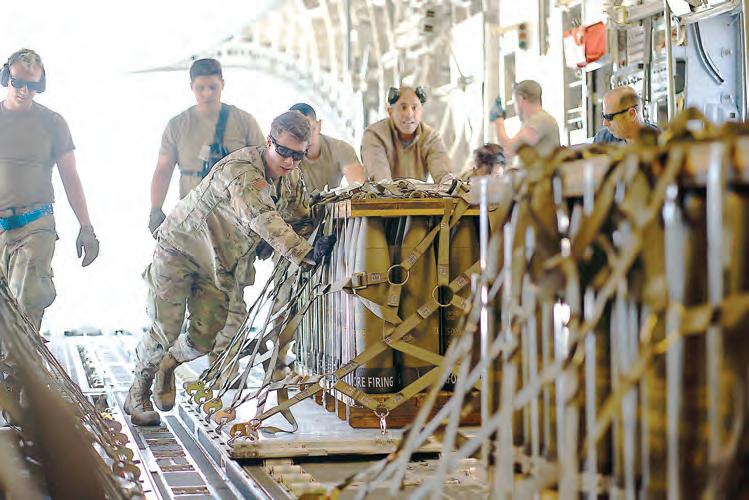
In the midst of all this, AMC pushed the limits of previous mobility operations around the world – all while providing Rapid Global Mobility for the United States, allies and partners.
“Last year, the mobility team was charged with understanding the assumptions of the future fight and paved an aggressive way forward to closing identified
gaps for ensuring victory for the joint force,” said Gen. Mike Minihan, AMC commander.
In March, Minihan announced the AMC strategy to win, codifying this directive and setting a vector for how Mobility airmen, with their truly global mission, deliver victory for America. To do that, empowered airmen need to “intentionally disrupt the status quo” and focus on “aggressively and urgently” closing capability gaps.
The command then presented those gaps to more than 200 DoD and Industry partners at its inaugural Summer Industry Preview held in July at Scott Air Force Base, Illinois. Attendees were invited back to the Airlift/Tanker Association conference in Denver, Colorado, in October, to
Serving Travis Air Force Base and the surrounding community

1250 Texas St., Fairfield, Calif. 94533 707-425-4646 | Fax 707-425-5924
Publishers: Foy S. McNaughton and T. Burt McNaughton
Advertising Director: Louis Codone
Distribution: Bob Franks
Editor: Glen Faison
Copy Editor: Todd R. Hansen
Layout : Robinson Kuntz
Photo Editor: Robinson Kuntz
present their solutions to AMC leaders and subject-matter experts.
AMC also hosted its 2022 Mobility Air Forces Weapons and Tactics Conference that focused on delivering Pacific-oriented solutions for the Joint Force. These events were part of a series that set AMC on a fast track to improve readiness.
“Nobody is going to care what our plans are for five to 10 years if we lose tomorrow,” Minihan said at the Air Force Association’s Air Space and Cyber conference in September, where he previewed the Mobility Manifesto. The document argues four key ideas: Airmen are the magic; lethality matters most; AMC is the Joint Force maneuver; and we need to invest in American tenacity to win now.
Travis Tailwind is a publication produced by the Daily Republic. All rights reserved. Reproduction in any form, in whole or in part, without written permission, is prohibited. Content published in Travis Tailwind is not necessarily the official view of, nor is it endorsed by, the U.S. government, the Department of Defense or the Department of the Air Force. The appearance of advertising in the publication, including inserts or supplements, does not constitute an endorsement by the Department of Defense, the Department of the Air Force or the Daily Republic of the products or services advertised.
Those off base who wish to receive home delivery of Travis Tailwind may call 707-427-6975. For information on paid advertising, call 707-425-4646. Correspondence may be sent to: Travis Tailwind/Daily Republic, 1250 Texas St., Fairfield, CA 94533.
“Our toys, our training, our desires are meaningless unless we maneuver them to unfair advantage and unrepentant lethality,” he said.
At the same event, Minihan announced the culmination of a yearlong sprint to operationalize the KC-46A, which had been utilized in multiple employment concept exercises to validate the aircraft’s ability to complete its mission.
“We are ready to use this aircraft globally in any fight, without hesitation,” he said, while announcing he had cleared the KC-46A for worldwide deployments to meet combatant command taskings.
In November, AMC presented the culmination of its efforts to build a winning scheme of maneuver in the Pacific to Air Force Chief of Staff Gen. CQ Brown, Jr. and other Air Force major command commanders that was built on the work of AMC’s Fight Club as well as multiple joint planning events and staff-to-staff exchanges. This marked a key milestone in preparing the command to execute Exercise Mobility Guardian in 2023, which will take place in the Indo-Pacific and demonstrate AMC’s role as the Joint Force maneuver.
AMC Airmen took to heart the challenge to extract maximum value from existing tools by executing various impressive, sometimes record-breaking operations, including a 72-hour KC-135 endurance mission, KC-46 limited crew flight, and a KC-46 36-hour endurance mission.
By December, AMC was tied in with U.S. Indo-Pacific Command, U.S. Strategic Command, USTRANSCOM, and their components to execute a bomber task force mission in the Pacific that demonstrated AMC’s role in providing global reach with rapid, agile and resilient mobility effects through multiple domains and
7 Puzzle 12-13 Worship services 14 Classifieds
Orlando Cepeda, 90th Logistics Readiness Squadron mobile metal mechanic, welds a piece of metal on F.E. Warren Air Force Base, Wyo., Nov. 29.
Joseph Coslet/U.S. Air Force
JOINT BASE SAN ANTONIO-LACKLAND, Texas — For most, this time of year is filled with love, happiness and peace. But, for families facing life-changing challenges like medical emergencies or the loss of a loved one, those feelings are hard to come by.
The Department of the Air Force Fisher House Program serves as a beacon of hope and provides comforts of a home during those difficult times.
“The 14 DAF houses at eight installations offer families a place to rest their head, a place to come together or even a place to grieve,” said Mary McLean, DAF Fisher House Program manager at the Air Force Services Center.
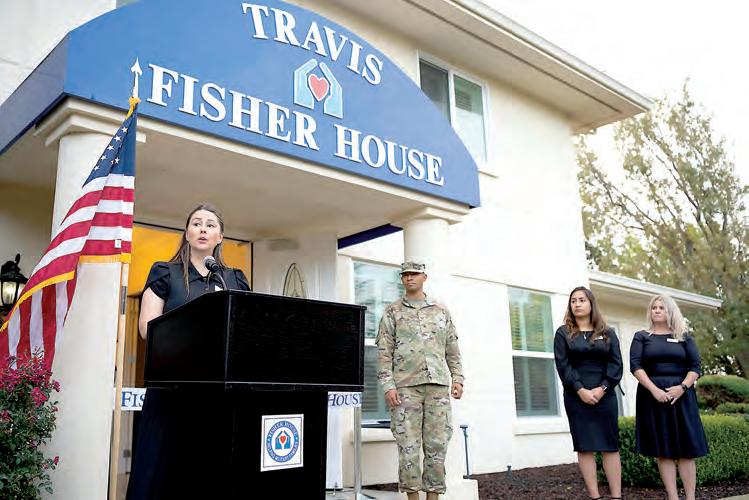
Ivana Jordovic, manager for the two Fisher Houses at Travis Air Force Base, recalls how right before the holiday season in 2019, the Travis Fisher Houses provided hope for a father and retired service member who stayed by his daughter’s bedside while she went through medical treatments at the base. While there, the family home was destroyed by wildfires that ravaged the state.
“They lost everything,” Jordovic said. “The Travis Fisher House meant so much to this family as they were going through all of this. It became their only home and it was our job to support them as they were not only dealing with their daughter’s treatments, but also trying to rebuild a life ravaged by wildfires.”
From the foundation’s inception in 1990 until recently, each Air Force Fisher House operated independently. In 2020, AFSVC, a primary subordinate unit of the Air Force Installation and Mission Support Center, began program management and oversight responsibilities to provide consistency of care for families.
McLean, as program manager, oversees the homes to ensure they receive the resources and support they need to take care of Airmen, Guardians and their families when they need it the most.
Each Fisher House provides up to
21 suites, including private bedrooms and baths, with a shared kitchen, laundry facilities, dining room and living room common areas. Families traveling to be near loved ones receiving medical treatment or to receive their fallen loved ones during a dignified transfer at Dover Air Force Base, Delaware, stay at no cost.
All Fisher Houses are furnished, operated and staffed using nonappropriated funds with the exception of Dover AFB’s Fisher House for Families of the Fallen which is staffed by military members through Air Force Mortuary Affairs Operations.
From helping house managers create and execute realistic nonappropriated fund budgets and accomplish renovation projects, to developing manager guidance and compliance standards across DAF Fisher House locations, McLean sees her role as the go-to person for answers and solutions – like when Winter Storm Uri damaged the JBSA-Lackland Fisher House about two years ago.
“We had just realigned under AFSVC
and were under a maintenance contract transition when the winter storm hit,” said Philip Harralson, Lackland Fisher House manager. “With leadership support, we worked with our base civil engineer to get the work completed as quickly as possible.”
“I’m an advocate for our house managers and help them find solutions to problems so they can remain focused on the families,” McLean said.
With leadership support being a critical component for success, the program manager conducts regular site visits and tours homes with installation leadership and civil engineers, sharing stories of families and the Fisher House mission along the way.
After a tour of the Lackland Fisher House campus, for example, the JBSALackland leadership team pledged to do everything they could to support the mission.
“Without their support after Winter Storm Uri, we never would have been able to get our operation back up and running,
as we had broken pipes and fire suppression issues in multiple houses,” McLean said. “Base leadership was amazing.”
Over the past three decades, the Fisher House Foundation has served more than 430,000 families across the Department of Defense, saving families an estimated $547 million in out-of-pocket costs for transportation and lodging.
In fiscal year 2022 alone, the DAF program assisted more than 3,800 families for a total of 22,778 bed nights. Volunteers also supported the Fisher Houses with more than 3,700 hours.
Keeping the houses up and running to Air Force standards sometimes requires additional funds and support. This is where AFSVC’s management support comes in.
As McLean builds relationships at each house, she works as the conduit for managers to request funding from the Fisher House Board, or in the case of Dover’s Fisher House for Families of the Fallen, from Headquarters Air Force.
“In the past, only medical professionals interacted with the Fisher House teams,” McLean said. “Now I meet with the wing, mission support group, civil engineering, force support squadrons and others, to stress the importance of the mission and the role of their respective agencies.”
“Going through a devastating illness or losing a loved one is traumatic and lifechanging. Mary and our Fisher House teams are dedicated to being there for our military members and their families at these most difficult times,” said Col. Carolyn Ammons, AFSVC commander.
“They make our Fisher Houses so much more than just four walls where families lay their heads,” the commander said. “They’re a ‘home away from home’ where they can breathe, relax and recharge in a comfortable, welcoming space.”
While hope and peace of mind for families dealing with crisis can be fleeting, AFSVC and Fisher House teams are doing their part to provide it where they can.
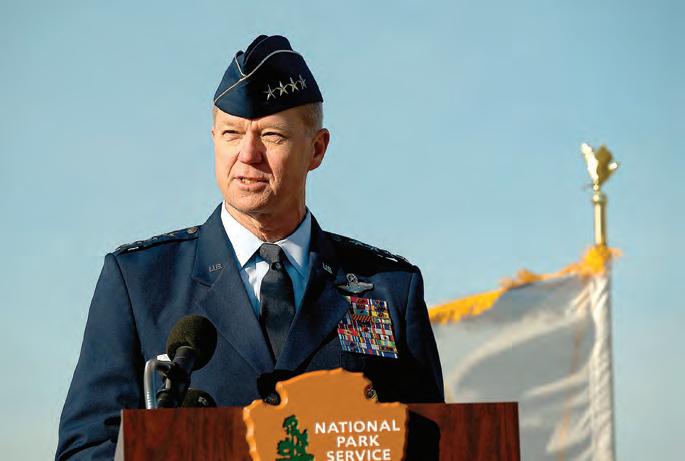
 Harris AIR COMBAT COMMAND PUBLIC AFFAIRS
Harris AIR COMBAT COMMAND PUBLIC AFFAIRS


JOINT BASE LANGLEY-EUSTIS, Va. (AFNS) — The First Flight Society recently hosted a celebration recognizing the 119th anniversary of the first powered and controlled flight, the 75th anniversary of the U.S. Air Force and the induction of Gen. Benjamin O. Davis Jr. into the Paul E. Garber First Flight Shrine. The event took place at the Wright Brothers’ National Memorial, North Carolina.
The ceremony included remarks from the National Park Service, First Flight Society, Tuskegee Airmen National Historic Site and Davis Jr.’s great nephew, Doug Melville. Gen. Mark Kelly, commander of Air Combat Command, delivered the keynote speech about the 75th anniversary of the Air Force, the impact the Wright Brothers had on modern aviation and the legacy Davis Jr. left for modern Airmen.
“We are the most feared and

revered Air Force in the world because of those who have gone before us, particularly those who weren’t afraid to break barriers, weren’t afraid to think differently, and weren’t afraid to be different,” Kelly said. “The Wright Brothers and Gen. Davis clearly were not afraid to break barriers.”
The theme of the Air Force’ 75th anniversary is, “Innovate, Accelerate and Thrive – The Air Force at 75.” Through this theme, the Air Force calls on Airmen to innovate in how they train and employ their squadrons, develop capabilities and continue to move toward a more effective Air Force. The Air Force accelerates through rapid changes in technology and demands placed on air superiority; global strike; rapid global mobility; intelligence, surveillance, and reconnaissance; and command and control.
Ultimately, the service thrives because of empowered airmen unafraid to forge their own path.
FAIRFIELD – Soroptimist International of Vacaville is looking for Solano County women in aviation to honor as part of the International Day of Women celebration in March.

Anyone who knows a woman who has made her career around aircraft – she can be military or civilian, employed or retired –share her story or self-nominate
by filling out a nomination form at www.VacavilleSoroptimist. org.

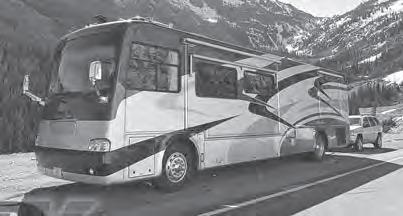
All nominees and nominators will be welcome to join the reception at the Vacaville Museum at 5 p.m. on March 8. The event coincides with the museum’s current exhibit, “Solano Skies.”

There is no charge for the event, but a reservation is required. Any active or retired female aviator is welcome. Space is limited.
Davis Jr., an aviation pioneer, was the first Black man to gradu ate from West Point since 1889, a member of the first aviation cadet training class at Tuskegee Army Airfield, and the first Black pi lot to solo a U.S. Army aircraft. With Davis as commander of the Tuskegee Airmen, the “Red Tails,” compiled an outstanding combat record against the Luft waffe in World War II. At the start of WW II, Davis and his fa ther Brig. Gen. Benjamin O. Da vis, were the only two Black offi cers in the military who weren’t chaplains and later they became the first two Black generals.
On Dec. 9, 1998, Davis Jr. be came the first Black officer to receive a fourth star in retirement. Leaders of firsts, Davis Jr. and his father carefully and See PIONEERS Page 10
Occupational hazards among medical workers can have a big impact on mission readiness.
The top four hazards medical workers face are slips, trips and falls, needle sticks; repetitive motion injuries; and lifting and handling injuries, according to the National Institute for Occupational Safety and Health.
The rate of lost-workday injuries resulting from slips, trips, and falls in hospitals is 90% greater than the average rate for all other private industries, according to the U.S. Bureau of Labor and Statistics. Slips, trips, and falls are the second-leading cause of lost-workday injuries in hospitals after overexertion.
Slips, trips, and falls are mostly due to fluid spillage and items left in walking paths (especially electrical cords), said Steve Sinatra, the lead safety manager at the Defense Health Agency’s Occupational Safety Branch.
Tips to avoid these injuries include:
n Keep hallways clear.

n Alert maintenance to slippery floors due to spills.
n Pick up dropped packages or bundles.
n Wear appropriate non-slip, non-skid footwear, especially in wet areas.

n Learn how to use ladders and stepstools appropriately for reaching higher items. Never use or stand on a chair with wheels.
Additionally, military medical treatment facilities should ensure the maintenance of exterior walkways, parking lots, and other areas where people may be walking.
Needle stick prevention is a priority as medical workers often deal with blood. Blood can
carry pathogens. Needles or other sharp objects such as burs and scissors also may expose health care workers to biological hazards, chemicals or drug exposures, and radioactive materials.
Air Force Capt. Lara Poole further explained: “There are many threats that our health care workers face when it comes to providing excellent patient care. One of these threats is needle stick and other sharps injuries,” said Poole, who is the public health flight commander, 316th Operational Medical Readiness Squadron, Malcolm Grow Medical Clinics & Surgery Center at Joint Base Andrews in Maryland.
Needle sticks and injuries from other sharp objects “can potentially expose health care workers to pathogens such as hepatitis B, hepatitis C, and human immunodeficiency virus (the virus that causes AIDS). These pathogens can pose life-threatening health issues or even a lethal risk to health care workers if left untreated,” Poole said.
To prevent sharps and needle stick injuries, keep these tips in mind:
n Wear goggles, a face shield and double gloves when suturing or administering a needle.
n Use a needle only one time. Do not recap it. Activate the safety immediately after use.
n Opt for safe sharps, such as retractable needles, blunt suture needles, safety scalpels, or needleless blood transfer equipment, if available.
n Empty the sharps container before it is full.
n Do not leave sharps out where they may injure others.
n Use mechanical devices to pass sharps. Never pass them by hand.
n Communicate with your colleagues and use verbal alerts when passing sharps.
n Keep exposed sharps in view at all times and be aware of anyone around you.
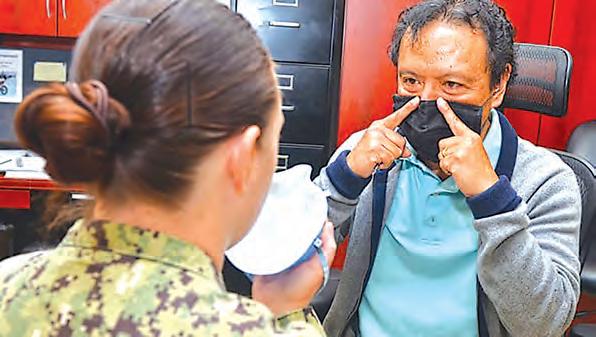
n Participate in blood-borne
pathogen training.
Repetitive motion injuries (RMIs) or repetitive strain injuries (RSIs) are work-related musculoskeletal disorders that can result from exposure to repetitive and forceful motions.
“In the upper extremities, these actions are commonly seen in fine motor tasks which can be found throughout medical settings such as pipetting, microscope use, manipulation of ultrasound wands, surgical, and other treatment instruments, microtome work in a pathology lab, and near constant use of handheld technology, computers, and medical equipment,” said Kelsey McCoskey, an ergonomist for the Army Public Health Center..
RSI and overuse can be felt in the nerves, muscles, ligaments, and tendons through repetitive stress micro-tears and inflammation of surrounding soft tissues,

McCoskey said. To lessen the chances of developing these injuries, she suggested:
n Take frequent 30- to
During winter months at Fort Wainwright in Alaska, the sun comes up around 10 a.m. and sets a little bit before 3 p.m. Along with the frigid weather, the extended darkness creates an increased risk of depression and other mental health problems.
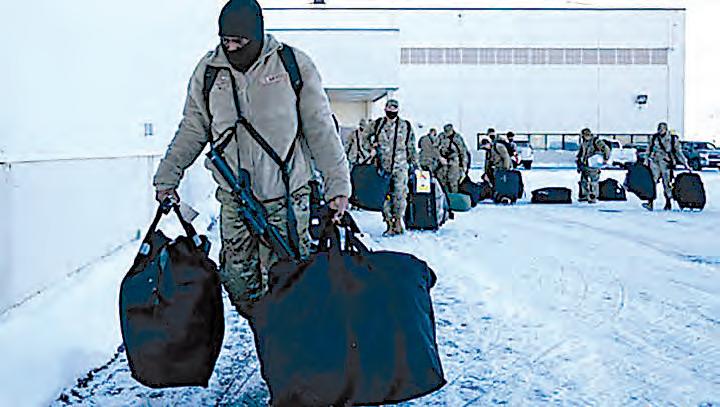
That’s why at installations like Fort Wainwright, military officials are acutely aware of the risks of Seasonal Affective Disorder, also known as SAD, which is the medical term for a seasonally triggered change in behavior that can affect anyone but especially at higher latitudes where the days are shortest.
SAD can be hard to recognize because its onset is as slow as the changing seasons.
“One of the most challenging things about identifying Seasonal Affective Disorder is that the onset can be very subtle,” said Army Capt. Julie Dederer, a psychologist at Bassett Army Community Hospital at Fort Wainwright near Fairbanks, Alaska, said.
“This can cause delays in patients identifying that something is wrong, and in accurately identifying it for treatment once the patient does seek treatment
for it.”
The problem becomes most acute around this time of year, near the winter solstice, or the northern hemisphere’s shortest day of the year, which usually falls on Dec. 21.
Anyone can be affected each year regardless of latitude.
“SAD can occur regardless of geographic location, especially if people have a history of mental health issues or depression,” said U.S. Public Health Service Officer Lt. Hana Kim, the assistant department head of the outpatient behavioral health department at the Navy Medicine Readiness and Training Command in Jacksonville, Florida.
There is a relatively high rate of reoccurrence “in that individuals who experience an episode of SAD are significantly more likely to experience another episode the next year,” Dederer said. The good news is that this “provides an opportunity for preventive measures.”
At Fort Wainwright, soldiers can borrow light boxes, which provide broad-spectrum light that mimics daylight. Light boxes are best used in the morning, Kim said.
“For mild to moderate SAD, light box therapy is the first line of therapy,” she said. For


more severe cases, antidepressant medications such as selective serotonin reuptake inhibitors, known as SSRIs, might be prescribed.
A good deal of treatment for SAD involves behavioral and lifestyle changes.
There are other contributing
factors to SAD and its severity, which can include reduced physical activity, poor diet, social isolation, and spending less time on enjoyable activities, Dederer said. To address some of these issues, she recommends:
n Low-fat diets n Reduced carbohydrates n Reduced refined sugars Dederer also suggested
lifestyle changes, including: n Finding new hobbies to stay active in the winter


n Making deliberate efforts to go outside during the daytime n Opening blinds to increase sun exposure
n Socializing more with family and friends
Additionally, she suggested
TRAVIS AIR FORCE BASE —
Military shoppers can start the new year with savings, thanks to MILITARY STAR®.
From Jan. 12 through 26, Travis shoppers who are approved for and use a new MILITARY STAR account will receive 15% off all purchases made on the first day instead of the regular 10% discount.
“MILITARY STAR can help the military community save and stick to their budgets with this special savings opportunity—in addition to the everyday deals and discounts that come with the card,” Travis BX General Manager Phonda Bishop. “Signing up for MILITARY STAR is a simple way to get greater value for your dollar.”
In addition to the 15% off firstday purchases, MILITARY STAR offers exclusive cardholder

savings, such as 5 cents off every gallon of gas at Army & Air Force Exchange Service fuel locations, 10% off at participating Exchange restaurants and free shipping on online orders.
Cardholders also earn unlimited 2% rewards on all purchases at exchanges, commissaries and online. (Rewards exclude Military Clothing line of credit.) All cardholders, regardless of credit
score, receive the same low APR and no annual, late or over-limit fees. Active-duty military members are also eligible for additional benefits such as a 0%-interest Military Clothing plan for qualifying uniform basics and a reduced-interest deployment plan with no payments.

The 15% discount applies to purchases made everywhere the MILITARY STAR card is

accepted, including all exchanges, commissaries and online at ShopMyExchange.com, myNavyExchange.com and ShopCGX. com. Department of Defense civilians and retirees are eligible to apply for a card. All honorably discharged Veterans who have confirmed their eligibility to shop at ShopMyExchange.com can use their MILITARY STAR card discount when shopping the Exchange online.
The first-day discount is dependent upon the application being approved and will be applied as a credit on the first monthly billing statement. For more information, visit MyECP.com.


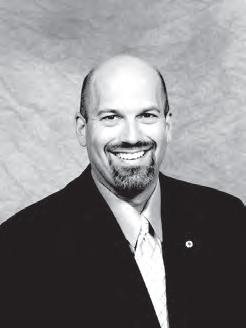
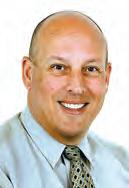
ARLINGTON, Va. (AFNS) —
Effective Jan. 1, advanced academic degrees will be visible to promotion central selection boards considering major and lieutenant colonel ranks. The change will apply to all eligible Department of the Air Force officers and allow promotion board members to consider an officer’s acquisition of valued expertise as one of many whole person concept considerations.

Operational and academic expertise, experience and high levels of job performance will be the most important factors when evaluating officers for promotion. Advanced academic degrees will be considered but will not be a requirement for, or a guarantor of, promotion.

“The United States, and
specifically the Department of the Air Force, are facing foreign competitors that include the most technologically capable and wellresourced competitor we have ever confronted,” said Secretary of the Air Force Frank Kendall. “We are also confronted by multiple competitors from vastly different cultures than our own. To compete with China, Russia, or other potential threats, the Air and Space Forces must incorporate new technology more rapidly and effectively than our competitors. We must also have a deep understanding of the history, motivations, doctrine, and thought processes of our potential adversaries.”
“To do this effectively, we need leaders and supporting staff throughout the DAF at all levels who have deep expertise in emerging technologies and their applications to military
operations. We must also have leaders with expertise in the cultures of our potential adversaries. Such expertise and associated critical thinking skills are developed from many sources and experiences, including advanced academic degree programs.”

In 2014, advanced academic degrees were masked to promotion boards for major and lieutenant colonel in conjunction with adjustments to displaying the method of completion of developmental education. It has been longstanding service practice to display advanced academic degrees for promotion boards to colonel and above.
Promotion board members
will be instructed to understand and appreciate the value of specific advanced academic degrees, military training and operational experience for the developmental category meeting the board.

“Officers should not pursue an advanced degree simply to impress a promotion board or to check a perceived box,” Kendall said. “Advanced degrees should be chosen to meet personal and professional goals, with an appreciation of the value of the specific degree has to the Department of the Air Force,” Kendall said.

The Air Force Personnel Center and Air Reserve Personnel Center will communicate directly with officers meeting promotion
boards in January through March 2023 to ensure eligible officers are aware of the change. Additionally, all officers will be notified where to find the guidance that promotion board members will receive regarding specific advanced academic degrees, military training and operational experiences for each developmental category, and specifically reminded to update their officer selection brief.

Officers may preview their records as the promotion board members will see them through the Personnel Records Display Application in myPers. Ahead of each promotion board, AFPC and ARPC will continue to provide details to eligible officers on how to update their advanced academic degree information.
For all officer promotion boards convening after March 2023, the service will follow the normal scheduled officer promotion process.
60-second breaks to stretch and change postures.
n Take many smaller breaks from repetitive tasks rather than one long break.
n Shift tasks in an effort to use different muscle groups.
n Keep proper posture at desks.
n Have an ergonomist review your office or work space.

n Try to take a break for a minute every 20 minutes or so to stand up, or move your feet, arms and hands in circular motions to promote blood flow and give your muscles a change of routine.
The constant moving of patients and heavy equipment can take a toll on health care workers’
backs and necks.
Identification of these workrelated musculoskeletal disorder risk factors and controls to minimize exposure can help reduce the potential for fatigue and discomfort and improve efficiency and effectiveness.
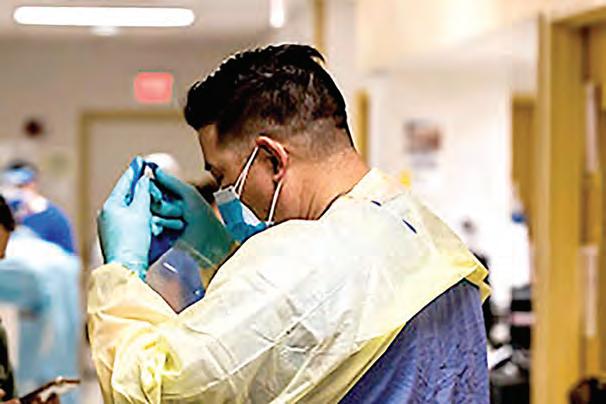
“Many people take manual lifting for granted,” Sinatra said “There is a technique to lifting properly, and supervisors must train their personnel on this technique.”
His tips for improved safety:
n Try not to lift something from the floor.
n Look at the box and see if it has the symbol for a two-person carry.
n Push the box with your foot to see how manageable it is for you to lift. If you don’t feel it’s manageable, stop and get help.
n If it is manageable, get close to the load, bending at the knees, keeping your back straight; then grasp the load with both hands, stand straight up without twisting
or turning and pull the load close to your body.
n Place the load on a device to push it to the destination, instead of carrying. Even using a chair with wheels is better than carrying a heavy box across the room.
n Remember that nothing beats a lifting device such as a hand truck, patient lifting device (sling), etc., but if you have to lift something, use the proper technique.
n Get assistance in moving a patient if necessary to do so safely for your and the patient.
“I’m a veteran of three back surgeries and know first-hand about how not being trained in the proper lifting techniques and how it can injure a person for life,” Sinatra said.
Assessing, designing, and modifying work environments to include administrative and engineering controls can help to
minimize these exposures.
McCoskey said: “Engineering controls may include automated medical equipment, equipment designed for adjustability, neutral postures, and low-force
requirements, equipment handles that are not too small or too large and fit comfortably in the hand, upper extremity supports, and workstation adjustability to accommodate multiple users.”
getting your vitamin D levels checked during the winter. Low vitamin D is a possible medical factor with SAD, although there is no conclusive scientific evidence to support that. Fort Wainwright provides free vitamin D supplements on-post.
Kim emphasized as important “good sleep hygiene – going to bed at the same time every night, no naps, and no caffeine in the afternoon.”
Additionally, she suggested adopting a “generally healthy lifestyle and exercising, which
releases good endorphins in the brain and can help counteract any weight gain caused by overeating, and limiting excess alcohol.”
At Wainwright, the potential for SAD is addressed immediately upon a service member’s arrival, regardless of the time of year.
Wainwright has an outreach component, where behavioral health staff brief every soldier within their first week on base. They discuss challenges in Alaska’s climate and environment, signs of SAD and resources for addressing the condition.
“The hope is that the brief
gives soldiers the information to encourage them to be proactive in identifying and preventing SAD symptoms,” Dederer said.
If SAD symptoms are identified in a soldier, the behavioral staff at Bassett “assess the extent to which symptoms might be seasonally driven” and recommend a treatment plan, she added.
“Beware of the challenges in comparing your own needs to those of the people around you,” Dederer said.
“In winter, many people socialize less, which means they interact with their friends less often,” she said.
For instance, “They may believe they are the only one struggling with the ‘winter blues’ and are reluctant to seek help due to stigma. Or they think everyone is experiencing the same thing and there is no reason or benefit to seeking help. Both comparisons can be harmful in preventing someone from seeking help to address their symptoms,” Dederer cautioned.
“The upside is that these interventions are easy to do on your own and accessible to pretty much anyone,” Dederer said.
“The downside however is that the nature of SAD is cyclical – those with SAD have lower
energy because of the reduced sunlight exposure, so they spend less time doing activities such as exercising and socializing with friends, and the withdrawal from these activities increases feelings of fatigue and depression, making it harder to put the lifestyle changes in place.”
“The most important thing is to not take it lightly,” Kim said. “Don’t chalk it up to winter blues, especially if you feel this way for more than two weeks.” Since SAD is a subtype of depression, it can lead to more severe depression and suicidal ideation.
“There are good treatment options for SAD, so reach out.”
From Page 4

strategically navigated a difficult time in American history.
“Ben and his dad lived as if they were invisible,” Melville explained, as he shared the story of the father and son who referred to themselves as “invisible generals.” “Ben wanted to live a long life and die as an old man. He felt the best way to do that was not to cause problems but to diffuse the system and act quietly, operating as if he were invisible so he could help make the change that we all wanted to see.”
After retirement from the Air Force, Davis Jr. led efforts to create the 55-mph speed limit to save lives and gas, the U.S. Marshal Service, Commercial Airport Security and the U.S. Air Force Thunderbirds. He dedicated his life to aviation.
“No airman embodies the idea of thriving in the warrior spirit of our Air Force with a past or present more so than our honoree today, General Benjamin O. Davis Jr.,” Kelly said. “I think General Davis is the epitome of what we call today ‘empowered Airman,’ and in turn, he empowered other Airmen to give us the competitive edge we still enjoy over our adversaries.”
Air Combat Command seeks
to organize, train and equip the best and brightest Airmen, necessary to fly, fight and win. Leaders like the Wright Brothers and Davis Jr. set the example for future Airmen from all backgrounds to promote positive change, break barriers and pave their own way in history.
Every year, the First Flight Society holds a celebration on Dec. 17 to recognize the Wright Brothers’ achievements in aviation. This year’s attendees included the great-great nephew of Wilbur and Orville Wright, Davis Jr.’s family members, members and families of Tuskegee Airmen and First Flight Society members.
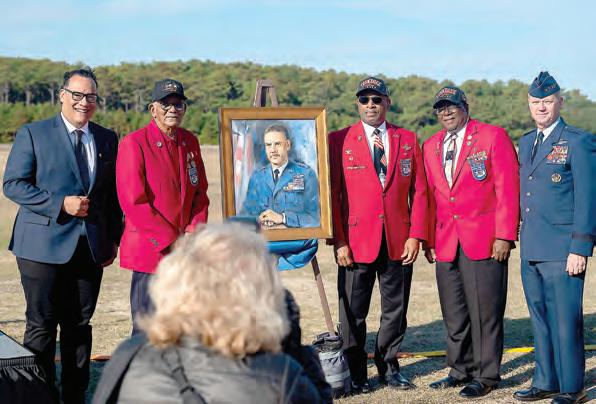
Annually, since 1966, a highlevel panel appointed by the First Flight Society selects and inducts a new member into the First Flight Shrine and unveils their portrait in the portrait gallery. This year, the society unveiled Davis Jr.’s portrait to be displayed until next year’s celebration.
Other aviation pioneers featured in the gallery include Wilbur and Orville Wright, William Edward Boeing, Wiley H. Post, Neil Armstrong, Edwin Aldrin, Michael Collins, President George H. Walker Bush and Rear Adm. Alan B. Shepard, Jr., among others.
The Washington Pos










WASHINGTON — President Joe Biden will honor 12 people with the Presidential Citizens Medal on Friday on the second anniversary of the Jan. 6 insurrection on the Capitol, for “exemplary contributions to our democracy,” a White House official said Thursday.
Those receiving the medal include seven police officials - both from the Capitol Police and D.C. police - who defended the Capitol on Jan. 6, three state and local officials who resisted pressure to overturn election results, and mother-and-daughter election workers in Georgia who faced threats and harassment.
The Presidential Citizens Medal is one of the country’s highest civilian honors and is given to those who have “performed exemplary deeds of service for their country or their fellow citizens.”
Friday marks two years since a violent mob of supporters of President Donald Trump stormed the Capitol in an unprecedented attack on Congress, seeking to stop the certification of Biden’s win. A congressional committee that spent 18 months investigating the attack found Trump’s conduct following the 2020 election
was to blame and recommended that he be barred from ever holding office again. Trump has announced he is running a third time for the presidency.
The 12 honorees include:
Brian D. Sicknick, a Capitol Police officer who died from injuries he sustained defending the Capitol on Jan. 6;
Harry Dunn, who defended the building against the rioters and faced racial slurs and harassment, according to the White House;
Caroline Edwards, the first law enforcement officer who was injured by rioters and sustained a traumatic brain injury;
Aquilino Gonell, who served as a Capitol Police sergeant and was injured during the attack;
Eugene Goodman, who diverted an angry mob from the Senate floor while senators were still evacuating;
Michael Fanone, a D.C. police officer who was injured while defending the Capitol on Jan. 6 and resigned from the department shortly after;
Daniel Hodges, another D.C. police officer who also suffered injuries during the attack;
Jocelyn Benson, who served as Michigan secretary of state and faced enormous
From Page 2


Yearacross the full spectrum of Joint operations.



All of these successes hinge on a Warrior Heart mentality – a readiness model that focuses on airmen’s development of mind, body, and craft to ensure they are prepared for a violent fight. Nowhere was this on display more than in recognizing the first anniversary of Operation Allies Refuge, the largest noncombatant evacuation operation
in American history, where Mobility Airmen moved more than 124,000 people out of harm’s way, often under hostile conditions. In October, AMC announced 96 Airmen received the Distinguished Flying Cross and 12 airmen the Bronze Star Medal in one of the largest such recognitions in history. The 621st Contingency Response Group earned the Gallant Unit Award.
Mobility airmen are bold, solution-oriented and empowered, and as AMC looks to 2023, the command is confident in its ability to project, maneuver, connect and sustain.
Whispering Bay Lane, Suisun City, CA 94585 707-425-1849 www.mcbcfs.org for more
1405 Kentucky Street Fair eld, CA 94533
Rev. Dr. Terry Long, Pastor Sunday Sunday School: 11:00 a.m.

Morning Worship Service: 12:00 p.m. Children’s Church: 11:30 a.m. Tuesday Prayer Meeting: 6:30-7:00 p.m. Bible Study: 7:00-8:00 p.m. Web Site: www.stpaulfair eld.org Email: stpaulbcfair eld@comcast.net Church Phone: 707-422-2003



1050 North Texas Street
Fair eld, CA 94533-0624
707-425-3138 www.holyspiritfair eld.org
Weekend Mass: Saturday • 5:00 pm & 7:00 pm (Spanish) Sunday • 6:00am (Spanish), 7:30, 9:00, 10:30am, 12:00pm, 2:00pm (Spanish), 7:00pm (Spanish)
Daily: M-F • 7:00am & 9:00am Saturday • 9:00am; Tues & Fri • 7:00pm (Spanish); Wed • 7:00pm (English) OLPH Confessions in
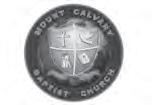


English: Saturday • 3:00-4:30pm Spanish: Tues & Fri • 4:00pm-6:00pm
CHURCH of CHRIST Meetsat
Rockville Cemetery
Stone Chapel
4221 Suisun Valley Rd, Fairfield


9:00 a.m. Sunday Morning Bible Study
9:50 a.m. Sunday Morning Worship
5:30 p.m. Sunday Evening Bible Study
7:00 p.m. Wednesday Evening Bible Study
We welcome and encourage you to come and hear the good news of the gospel of Christ, and to learn about eternal salvation for all mankind that is offered through Jesus.
“And there is salvation in no one else; for there is no other name under heaven that has been given among men by which we must be saved.” Acts 4:12
Bring a heart and mind willing to hear God’s Word and to do His great will... For more information or directions, please visit our website at www.rockvillecofc.com



DALLAS — The U.S. government will expand humanitarian passage monthly for as many as 30,000 people from Cuba, Nicaragua, Haiti and Venezuela under a broad measure designed to grapple with historic migration from
the Western Hemisphere, senior White House officials announced Thursday.

Under the program, the immigrants must have an eligible sponsor and pass a vetting process to come to the U.S. for up to two years and receive work authorization, officials of President Joe Biden’s administration said in a briefing Thursday morning.
The measure is similar to an earlier smaller initiative announced in mid-October for Venezuelans. Administration officials
emphasized the result was a decrease in migration from that country.
The measures come as unlawful migration continues to swell at record levels at the southwest border.
“Economic and political instability is fueling some of the highest levels of migration we’ve seen since World War II,” said a senior administration official, who spoke to reporters under the condition he not be named.
From Page 11


pressure - including from armed protesters outside her house - to overturn the election results;

Russell “Rusty” Bowers, then the Arizona House speaker who also pushed back on efforts to overturn election results; Al Schmidt, then the city commissioner on the
Philadelphia County Board of Elections who ensured votes were counted even as proTrump figures pressured him to overturn the results;

Ruby Freeman and Shaye Moss, a mother-and-daughter duo who both served as election workers in Fulton County, Ga., will also receive the medal. The two endured threats and harassment after the election.

2003 Chevy Tahoe LT.
All pwr., lthr., clean, v8 , 5.3 L, 183k mi C lean title & smog
$ 6,900 obo DL R
# 42203. (707)2806816 Quinterosautosales.com
2009 Piolet EX-L. A/T, v-6, all pwr., lthr., DVD Nav., moonroof. 121k mi. 2wd. $10,900 obo D LR #42203
( 707)280-6816 Quinterosautosales.com
2014 Accord Sports. A/T, all pwr., great on gas, 4 cyl., 126k. New oil, tires, etc. $13,900 o bo. DLR #42203
( 707)280-6816 Quinterosautosales.com




SEATTLE — After a dozen expeditions and decades of searching, it was a couple of pieces of waterlogged wood and a fearful octopus that helped two inventive mariners find the wreckage of the SS Pacific.
The legendary steamship sank in 1875 somewhere between British Columbia and San Francisco. The 220-foot vessel was carrying gold worth $5 million today, 230 tons of coal and more than 325 passengers when it was struck by a schooner that mistook it for a lighthouse. Only two survived.
Nearly 150 years later, a few miles south of Cape Flattery, as Jeff Hummel and Matthew McCauley used submergible drones to zero in on what they believed was the Pacific, they spotted an octopus with a tentacle wrapped around an object seemingly made of copper, maybe from the ship.
“We just sat there and stared at her in disbelief,” Hummel said. “And we’re like, well, this must be our shipwreck because every good shipwreck has an octopus.”
His granddaughter named it Lilly, but the cephalopod was gone by the next dive.
In November, Rockfish Inc. was granted exclusive federal rights to salvage what remains of the Pacific. Hummel is president of Rockfish and director of the Northwest Shipwreck Alliance.
His background is in marine navigation systems and product design; McCauley’s is in business, diving, history and communications. They launched NSA when both were students at Mercer High School. In 1984, they were sued by the U.S. Navy and won, giving them the rights to a World War II plane they found in Lake Washington.
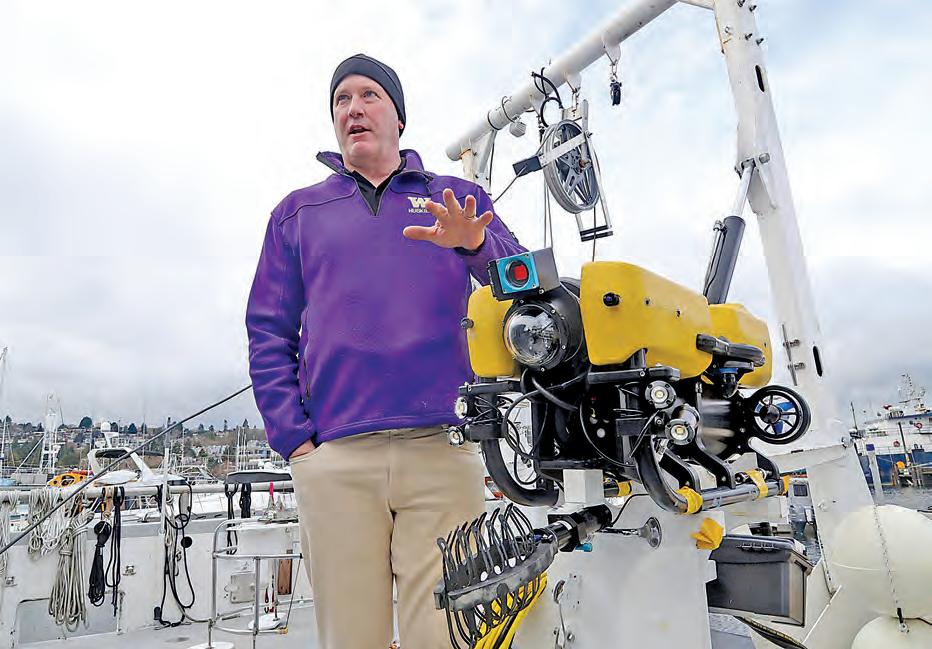
The pair have been salvaging
planes and ships together for decades, but the Pacific is unique.
Clues leading to the wreckage had escaped treasure hunters for more than a century.
The ship was bound for San Francisco during the gold rush when it entered a treacherous storm. Navigational tools in the 19th century were not advanced.
The morning of Nov. 4, 1875, the Pacific collided with the sailing vessel Orpheus, following a communication that led the schooner to turn when it shouldn’t have. The captain of the Orpheus was held responsible for what happened to the Pacific, but was not punished.
The Pacific’s captain, Jefferson Davis Howell, was commander of a rebel gunboat during the Civil War. His brother-in-law was former Confederate President Jefferson Davis.
The day before its demise, the ship had picked up passengers in Seattle, Olympia and other small towns on Puget Sound. S.P. Moody, owner of what was then the largest lumber mill in the west, notably came onboard in Victoria, British Columbia.
The kaleidoscopic cargo included wealthy travelers, miners, immigrants, a lumber tycoon and a circus troupe with performing horses.
In many ways the steamboat was as much a slice of gold rush America as much as it was a slice of the Pacific Northwest.
The wreckage is about 23 miles offshore and scattered across a slope about 1,000 to 3,000 feet deep. The work to clear the surrounding debris field could begin as early as 2023, while salvaging the main site will likely start the following year.
Parts of the salvage area are in international waters, so to claim federal protection of the site, the shipwreck alliance needed to bring a piece of the wreckage to
On board the salvage ship Seablazer,
shipwreck, with the remote
court. What they brought was a piece of brick that was likely part of the ship’s steam boiler, and planking from its hull.
“Based on what we’ve seen so far, we believe that there are artifacts on the ship that will blow people’s minds,” said Hum mel, who also captains the RV Seablazer.
Rockfish is a company built solely for salvaging the Pacific, and Hummel’s efforts to recover the wrecked steamship have been supported for years by 45 bene factors contributing $2.1 million.
Aboard the Seablazer in De cember in Seattle’s Salmon Bay, mounted on rolling carts next to Hummel were the two submerg ible drones – nicknamed Falkor

and Draco — used to case underwater sites. He designed and built the drones, along with other robotics used in a dozen expeditions to arduously narrow in on the Pacific.
“It’s better to leave it where it is than to do it wrong,” Hummel said.

The salvagers will first recover the surrounding site, as stretches of seabed have been raked in different directions by trawling nets. Then their efforts will focus on the ship itself.
It’s unlikely any human remains will be found after so much time has elapsed.
Still, sonar and video footage of the site indicates a shipwreck in “remarkable condition.”
Everything recovered will be subject to claim by family members, as the legal process demands. After that, Hummel and McCauley said the plan is to build a museum somewhere near Puget Sound. Profits will be shared among the volunteer crew, but finding and safely retrieving objects that have been submerged for more than a century will be a challenge.
